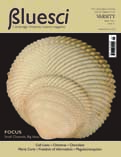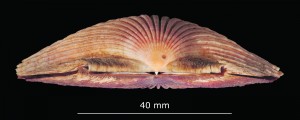SATURDAY, 7 MAY 2011
Combing beaches and collecting pretty shells is a common childhood hobby. For some the enjoyment continues into adulthood, maybe even formalising it as a scientific interest. Robert MacAndrew, whose collection now forms the nucleus of the shell collection at the University Museum of Zoology, was one of those.As the owner of a shipping company, he took the ample opportunities his ships provided to collect mollusc shells from the North Atlantic, Mediterranean and Gulf of Suez, gaining fellowship of the Royal Society for his work. MacAndrew was one of the pioneers of deep sea dredging, working closely with prominent naturalist Edward Forbes. They reported annually to the British Association for the Advancement of Science on the material that they recovered from increasingly greater depths.
On the cover is Divaricella macandrewae, from MacAndrew’s collection, showing beautiful intersecting ribbing that helps it to burrow. This specimen was collected from the Gulf of Suez in early 1869, before the opening of the Suez Canal later that year. It forms part of a larger collection of shells that provide a baseline from which to gauge the extent of subsequent animal migrations between the Red Sea and Mediterranean via the Suez Canal, which are called ‘Lessepsian’ migrations after the engineer of the Canal.
This is not the only example of molluscs affected by human activities. According to the 2010 statistics of the International Union for Conservation of Nature, 44% of the animal species that have been recorded as becoming extinct since the year 1500 have been molluscs. Several species of mollusc in the collection have already become extinct, due to habitat destruction and introduction of invasive species to their vulnerable habitats.
MacAndrew bequeathed his collection of mollusc shells to the University Museum of Zoology on his death in 1873. It now forms part of a wider collection of mollusc specimens assembled there, one of several collections of international significance in the museum that have led to it receiving designated status by the Museums, Libraries and Archives Council (MLA). Most notable in the MacAndrew collection is the large number of type specimens. These are the original specimens of a species to be scientifically described, and form the cornerstone of species definitions. MacAndrew was also interested in collecting growth series, mounting specimens of each species at various stages of development on his signature blue card, so increasing the value of his collection as a reference tool. The majority of the specimens, by necessity, are stored in great cabinets behind the public face of the museum, but work is afoot to open this great resource up to the public.
Recently, a project was undertaken at the museum to produce an online catalogue of all their bivalve molluscs. Bivalves have shells consisting of two halves hinged along one edge by interlocking teeth and flexible ligaments. The group includes clams, oysters and mussels. During the last eleven months, Hilary Ketchum has catalogued every one of the ten thousand bivalve molluscs in the museum’s collection. Each of the 200 or so molluscan type specimens have been photographed by Jamie Gundry, examples of which we see on the front cover and on this page. The bivalve collection is now fully recorded online, meaning that researchers can view good quality images of type specimens from remote locations, reducing the need to send material out on loan. A key strength is the ability to search by sampling sites, collectors or dates of collection.
This project, sponsored by a designated development fund of MLA, is another step to achieving the museum’s long term aim of cataloguing all of its specimens online, giving the whole world access to these rich scientific resources.
If you want to see examples of the shells yourself, a new display has opened at the University Museum of Zoology, showing bivalves thematically displayed according to their lifestyles.
Tom Ash is a PhD student in the Department of Clinical Neurosciences


